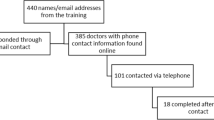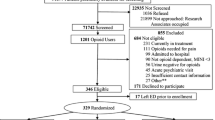Abstract
Background
Buprenorphine is a safe, effective and underutilized treatment for opioid dependence that requires special credentialing, known as a waiver, to prescribe in the United States.
Objective
To describe buprenorphine clinical practices and barriers among office-based physicians.
Design
Cross-sectional survey.
Participants
Two hundred thirty-five office-based physicians waivered to prescribe buprenorphine in Massachusetts.
Measurements
Questionnaires mailed to all waivered physicians in Massachusetts in October and November 2005 included questions on medical specialty, practice setting, clinical practices, and barriers to prescribing. Logistic regression analyses were used to identify factors associated with prescribing.
Results
Prescribers were 66% of respondents and prescribed to a median of ten patients. Clinical practices included mandatory counseling (79%), drug screening (82%), observed induction (57%), linkage to methadone maintenance (40%), and storing buprenorphine notes separate from other medical records (33%). Most non-prescribers (54%) reported they would prescribe if barriers were reduced. Being a primary care physician compared to a psychiatrist (AOR: 3.02; 95% CI: 1.48–6.18) and solo practice only compared to group practice (AOR: 3.01; 95% CI: 1.23–7.35) were associated with prescribing, while reporting low patient demand (AOR: 0.043, 95% CI: 0.009–0.21) and insufficient institutional support (AOR: 0.37; 95% CI: 0.15–0.89) were associated with not prescribing.
Conclusions
Capacity for increased buprenorphine prescribing exists among physicians who have already obtained a waiver to prescribe. Increased efforts to link waivered physicians with opioid-dependent patients and initiatives to improve institutional support may mitigate barriers to buprenorphine treatment. Several guideline-driven practices have been widely adopted, such as adjunctive counseling and monitoring patients with drug screening.

Similar content being viewed by others
Reference
Center for Substance Abuse Treatment, Substance Abuse Treatment and Mental Health Services Administration, US Department of Health and Human Services. The determinations report: A report on the physician waiver program established by the Drug Addiction Treatment Act of 2000 (“DATA”). Available at: buprenorphine.samhsa.gov/SAMHSA_Determinations_Report.pdf. Accessed: May 16, 2008.
Kakko J, Svanborg KD, Kreek MJ, Heilig M. One-year retention and social function after buprenorphine-assisted relapse prevention treatment for heroin dependence in Sweden: a randomised, placebo-controlled trial. Lancet. 2003;361(9358):662–8.
Alford DP, LaBelle CT, Richardson JM, et al. Treating homeless opioid dependent patients with buprenorphine in an office-based setting. J Gen Intern Med. 2007;22(2):171–6.
Stein MD, Cioe P, Friedmann PD. Buprenorphine retention in primary care. J Gen Intern Med. 2005;20(11):1038–41.
Mintzer IL, Eisenberg M, Terra M, MacVane C, Himmelstein DU, Woolhandler S. Treating opioid addiction with buprenorphine-naloxone in community-based primary care settings. Ann Fam Med. 2007;5(2):146–50.
Magura S, Lee SJ, Salsitz EA, et al. Outcomes of buprenorphine maintenance in office-based practice. J Addict Dis. 2007;26(2):13–23.
Mattick RP, Kimber J, Breen C, Davoli M. Buprenorphine maintenance versus placebo or methadone maintenance for opioid dependence. Cochrane Database Syst Rev. 2004;(3):CD002207
Johnson RE, Jaffe JH, Fudala PJ. A controlled trial of buprenorphine treatment for opioid dependence. JAMA. 1992;267(20):2750–5.
Johnson RE, Chutuape MA, Strain EC, Walsh SL, Stitzer ML, Bigelow GE. A comparison of levomethadyl acetate, buprenorphine, and methadone for opioid dependence. N Engl J Med. 2000;343(18):1290–7.
Fudala PJ, Bridge TP, Herbert S, et al. Office-Based Treatment of Opiate Addiction with a Sublingual-Tablet Formulation of Buprenorphine and Naloxone. N Engl J Med. 2003;349(10):949–8.
O'Connor PG, Carroll KM, Shi JM, Schottenfeld RS, Kosten TR, Rounsaville BJ. Three Methods of Opioid Detoxification in a Primary Care Setting: A Randomized Trial. Ann Intern Med. 1997;127(7):526–30.
Ling W, Charuvastra C, Collins JF, et al. Buprenorphine maintenance treatment of opiate dependence: a multicenter, randomized clinical trial. Addiction. 1998;93(4):475–486.
Drug Addiction Treatment Act of 2000. Public Law 106–310, Page 114 STAT.1101-Page 114 STAT.1227. 8-2-0005.
Center for Substance Abuse Treatment. Clinical guidelines for the use of buprenorphine in the treatment of opioid addiction. Treatment Improvement Protocol (TIP) Series 40.DHHS Publication No. (SMA) 04–3939. 2004. Rockville, MD.
Confidentiality of Alcohol and Drug Abuse Patient Records. Code of Federal Regulations Title 42, Volume 1, Chapter 1, Part 2. Available at: http://www.2hs.gov/ohrp/documents/19750701.pdf. Accessed: May 16, 2008.
Bivol, S. National poll of physicians on barriers to widespread buprenorphine use. 2003. Boston, Join Together. 8-29-2007.
Kissin W, McLeod C, Sonnefeld J, Stanton A. Experiences of a national sample of qualified addiction specialists who have and have not prescribed buprenorphine for opioid dependence. J Addict Dis. 2006;25(4):91–103.
Center for Health Information, Statistics, Research, and Evaluation, Bureau of Substance Abuse Services, Massachusetts Department of Public Health. Opioids: Trends and Current Status in Massachusetts. Available at: www.mass.gov/Eeohhs2/docs/dph/injury_surveillance/opioid_trends_2007.doc. Accessed: May 16, 2008.
West JC, Kosten TR, Wilk J, et al. Challenges in increasing access to buprenorphine treatment for opiate addiction. Am J Addict. 2004;13(Suppl 1):S8–S16.
Wolinsky FD. Why physicians choose different types of practice settings. Health Serv Res. 1982;17(4):399–419.
Gaulier JM, Marquet P, Lacassie E, Dupuy JL, Lachatre G. Fatal intoxication following self-administration of a massive dose of buprenorphine. J Forensic Sci. 2000;45(1):226–8.
Becker WC, Fiellin DA. Provider satisfaction with office-based treatment of opioid dependence: a systematic review. Subst Abus. 2005;26(1):15–22.
Cunningham CO, Kunins HV, Roose RJ, Elam RT, Sohler NL. Barriers to obtaining waivers to prescribe buprenorphine for opioid addiction treatment among HIV physicians. J Gen Intern Med. 2007;22(9):1325–9.
Turner BJ, Laine C, Lin YT, Lynch K. Barriers and facilitators to primary care or human immunodeficiency virus clinics providing methadone or buprenorphine for the management of opioid dependence. Arch Intern Med. 2005;165(15):1769–76.
Acknowledgements
The authors would like to thank Amber Jamanka, Jacqueline Ashba, and Andrew Hanchett for data management and analysis contributions, Colleen Labelle, RN, for assistance with survey design and feedback on the manuscript, and Courtney Pierce for assistance in preparing the manuscript. This project was funded by the Massachusetts Department of Public Health. Parts of this work were presented at the Society of General Internal Medicine New England regional meeting, 23 March 2007, the College on Problems in Drug Dependence annual meeting, 19 June 2007, and the Association for Medical Education and Research in Substance Abuse annual meeting, 9 November 2007.
Conflict of Interest
None disclosed.
Author information
Authors and Affiliations
Corresponding author
Rights and permissions
About this article
Cite this article
Walley, A.Y., Alperen, J.K., Cheng, D.M. et al. Office-Based Management of Opioid Dependence with Buprenorphine: Clinical Practices and Barriers. J GEN INTERN MED 23, 1393–1398 (2008). https://doi.org/10.1007/s11606-008-0686-x
Published:
Issue Date:
DOI: https://doi.org/10.1007/s11606-008-0686-x




